#2nd Canadian Infantry Brigade
Text
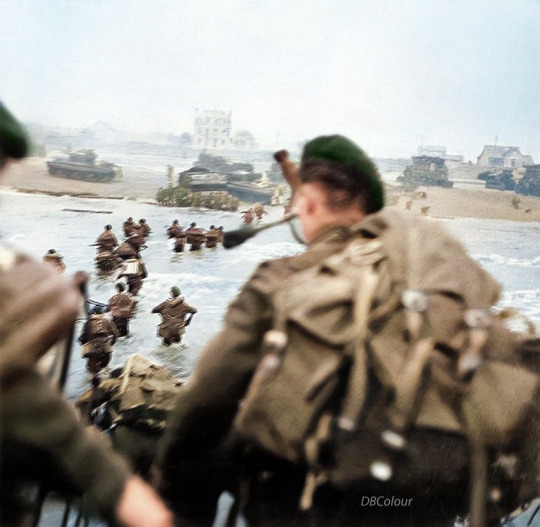

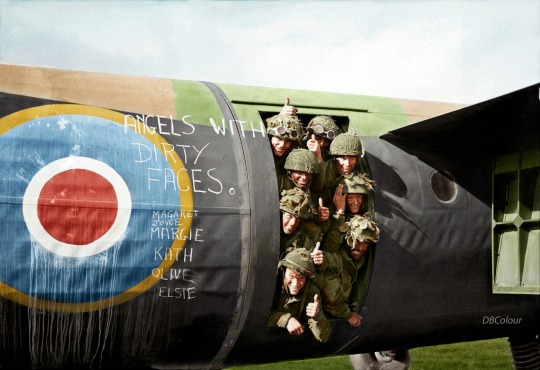

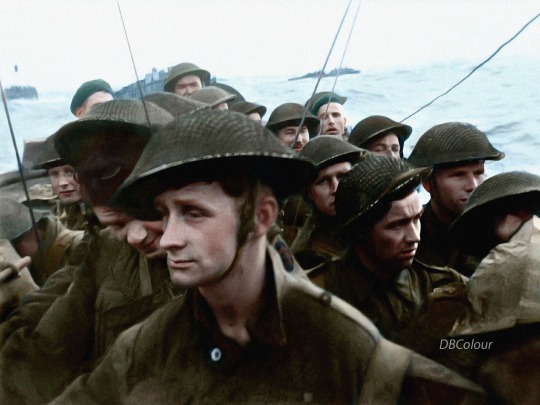

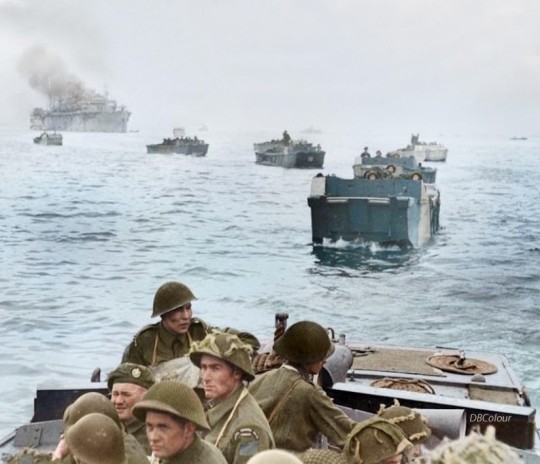

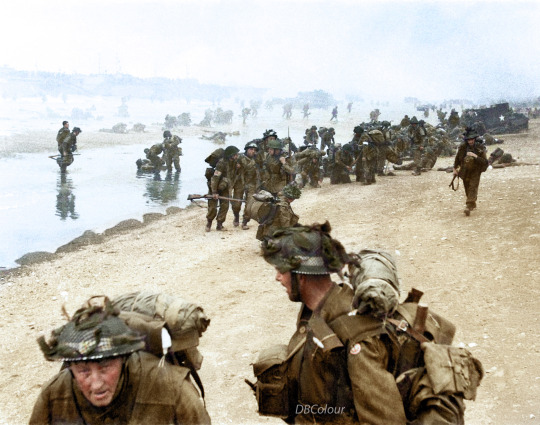
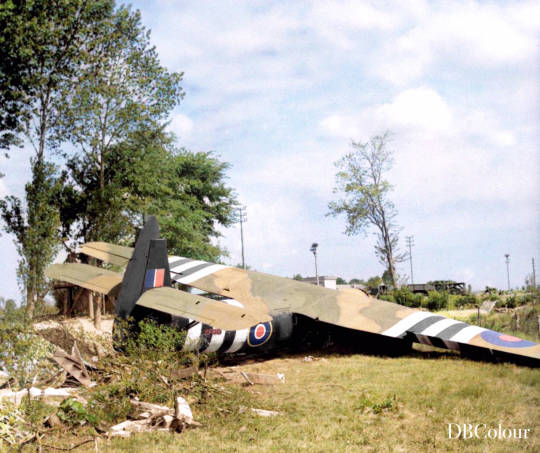
To commemorate the anniversary of D-Day, a short thread of photos colourised by DBColour (Colourising History on Facebook). Descriptions run from top-to-bottom.
Piper Bill Millin, seen here landing on Sword Beach with his bagpipes with Lord Lovat’s Commandos of 1st Special Service Brigade. IWM B 5103.
Commandos of 1st Special Service Brigade after landing on Queen Red beach, Sword area, 6 June 1944.
British Airborne troops smile from the door of their Horsa glider as they prepare to fly out as part of the second drop on Normandy on the night of 6th June 1944.
LCI(L) 135 of the 2nd Canadian (262nd RN) Flotilla carrying personnel of the North Nova Scotia Highlanders and the Highland Light Infantry of Canada en route to France on D-Day, 6 June 1944.
(Library and Archives Canada Photo, MIKAN Nº. 3205043)
Film still from the D-Day landings showing commandos aboard a landing craft on their approach to Sword Beach, 6 June 1944.
LCA (Landing Craft Assault) containing soldiers from the Winnipeg Rifles head for the Normandy Juno beach - June 6, 1944.
Commandos approach Sword Beach in a Landing Craft Infantry (LCI). Ahead, the beach is crowded with tanks and vehicles of 27th Armoured Brigade and 79th Armoured Division.
Troops of 3rd Infantry Division on Queen Red beach, Sword area, circa 0845 hrs, 6 June 1944. In the foreground are sappers of 84 Field Company Royal Engineers. Behind them, medical orderlies of 8 Field Ambulance, RAMC, can be seen assisting wounded men.
A Horsa glider near the Caen Canal bridge at Benouville, 8 June 1944. No. 91 (PF800), carried Major John Howard and Lieutenant Den Brotheridge of No.1 Platoon, 'D' Co., 2nd Battalion Oxfordshire and Buckinghamshire Light Infantry in the early hours of D-Day. © IWM B 5232
#d-day#d-day anniversary#ww2#world war 2#second world war#history#military history#british army#lest we forget#remembrance
295 notes
·
View notes
Text

An early memorial at Vimy Ridge in October 1917 honours the 2nd Canadian Division and the13th British Infantry Brigade that fought together during the battle. Memorials were often erected by units and formations after major battles.
#historical photos#world war 1#wwi#1917#the first world war#world war one#the great war#history#canadian history#ww1
34 notes
·
View notes
Text

#DDay80 🍁 On June 6th, 1944, the 3rd Canadian Infantry Division and the 2nd Armoured Brigade were tasked with establishing a bridgehead at Juno Beach. This was an 8 km stretch of beach between Sword and Gold landing beaches.
2 notes
·
View notes
Text
Events 8.19 (after 1930)
1934 – The first All-American Soap Box Derby is held in Dayton, Ohio.
1934 – The German referendum of 1934 approves Adolf Hitler's appointment as head of state with the title of Führer.
1936 – The Great Purge of the Soviet Union begins when the first of the Moscow Trials is convened.
1940 – First flight of the B-25 Mitchell medium bomber.
1941 – Germany and Romania sign the Tiraspol Agreement, rendering the region of Transnistria under control of the latter.
1942 – World War II: Operation Jubilee: The 2nd Canadian Infantry Division leads an amphibious assault by allied forces on Dieppe, France and fails.
1944 – World War II: Liberation of Paris: Paris, France rises against German occupation with the help of Allied troops.
1945 – August Revolution: Viet Minh led by Ho Chi Minh take power in Hanoi, Vietnam.
1953 – Cold War: The CIA and MI6 help to overthrow the government of Mohammad Mosaddegh in Iran and reinstate the Shah Mohammad Reza Pahlavi.
1955 – In the Northeast United States, severe flooding caused by Hurricane Diane, claims 200 lives.
1960 – Cold War: In Moscow, Russia, Soviet Union, downed American U-2 pilot Francis Gary Powers is sentenced to ten years imprisonment by the Soviet Union for espionage.
1960 – Sputnik program: Korabl-Sputnik 2: The Soviet Union launches the satellite with the dogs Belka and Strelka, 40 mice, two rats and a variety of plants.
1964 – Syncom 3, the first geostationary communication satellite, is launched. Two months later, it would enable live coverage of the 1964 Summer Olympics.
1965 – Japanese prime minister Eisaku Satō becomes the first post-World War II sitting prime minister to visit Okinawa Prefecture.
1978 – In Iran, the Cinema Rex fire causes more than 400 deaths.
1980 – Saudia Flight 163, a Lockheed L-1011 TriStar burns after making an emergency landing at Riyadh International Airport in Riyadh, Saudi Arabia, killing 301 people.
1980 – Otłoczyn railway accident: In Poland's worst post-war railway accident, 67 people lose their lives and a further 62 are injured.
1981 – Gulf of Sidra Incident: United States F-14A Tomcat fighters intercept and shoot down two Libyan Sukhoi Su-22 fighter jets over the Gulf of Sidra.
1987 – Hungerford massacre: In the United Kingdom, Michael Ryan kills sixteen people with a semi-automatic rifle and then commits suicide.
1989 – Polish president Wojciech Jaruzelski nominates Solidarity activist Tadeusz Mazowiecki to be the first non-communist prime minister in 42 years.
1989 – Several hundred East Germans cross the frontier between Hungary and Austria during the Pan-European Picnic, part of the events that began the process of the Fall of the Berlin Wall.
1991 – Dissolution of the Soviet Union: The August Coup begins when Soviet President Mikhail Gorbachev is placed under house arrest while on holiday in the town of Foros, Ukraine.
1991 – Crown Heights riot begins.
1999 – In Belgrade, Yugoslavia, tens of thousands of Serbians rally to demand the resignation of Federal Republic of Yugoslavia President Slobodan Milošević.
2002 – Khankala Mi-26 crash: A Russian Mil Mi-26 helicopter carrying troops is hit by a Chechen missile outside Grozny, killing 118 soldiers.
2003 – A truck-bomb attack on United Nations headquarters in Iraq kills the agency's top envoy Sérgio Vieira de Mello and 21 other employees.
2003 – Shmuel HaNavi bus bombing: A suicide attack on a bus in Jerusalem, planned by Hamas, kills 23 Israelis, seven of them children.
2004 – Google Inc. has its initial public offering on Nasdaq.
2005 – The first-ever joint military exercise between Russia and China, called Peace Mission 2005 begins.
2009 – A series of bombings in Baghdad, Iraq, kills 101 and injures 565 others.
2010 – Operation Iraqi Freedom ends, with the last of the United States brigade combat teams crossing the border to Kuwait.
2013 – The Dhamara Ghat train accident kills at least 37 people in the Indian state of Bihar.
1 note
·
View note
Text
4TH CANADIAN INFANTRY BRIGADE NARRATIVE OF OPERATIONS. SOUTH OF SCARPE 26TH, 27TH, AND 28TH AUGUST, 1918.
4TH CANADIAN INFANTRY BRIGADE NARRATIVE OF OPERATIONS. SOUTH OF SCARPE 26TH, 27TH, AND 28TH AUGUST, 1918.
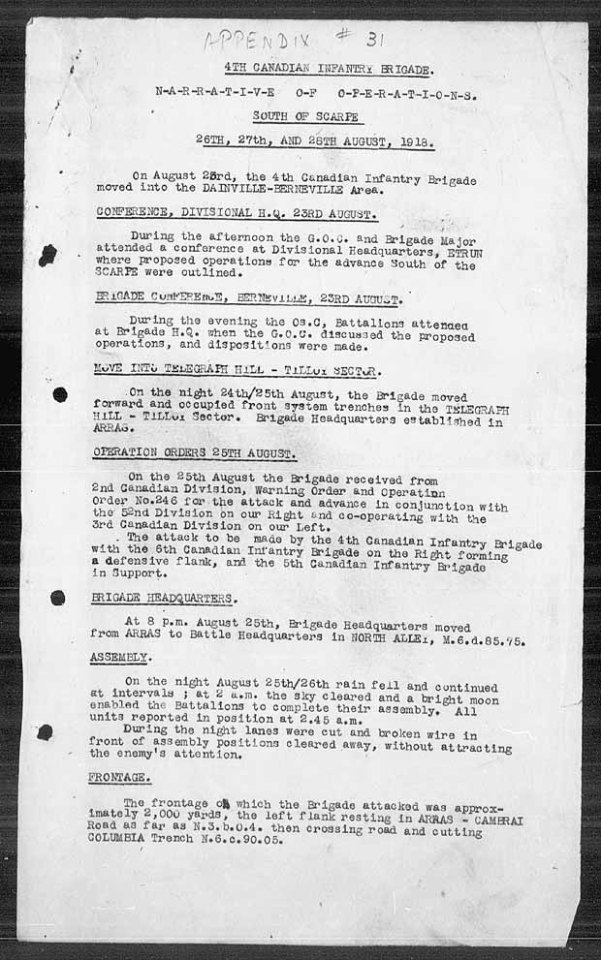
View On WordPress
#"B" Company 9th Battalion Tank Corps#18th Canadian Infantry Battalion#19th Canadian Infantry Battalion#20th Canadian infantry Battalion#21st Canadian Infantry Battalion#2nd Canadian Infantry Brigade#31st Canadian Battalion#3rd Canadian Division#4th Canadian Infantry Brigade#5th Canadian Infantry Brigade#6th Brigade#8th Canadian Infantry Brigade#Arras-Cambria Road#BUCK Trench#CABLE Trench#CURLEW Trench#EGRET Trench#enemy aircaft#Field Guns#Guemappe#Lewis guns#limbers#Lt. Col. B.O. HOOPER MC#Lt. Col. H.E. PENSE DSO#Lt. Col. L.H. MILLEN DSO#machine gun nest#MAJOR J.A. McINTOSH#MC#MINORCA TRENCH#NORTH ALLEI
0 notes
Text
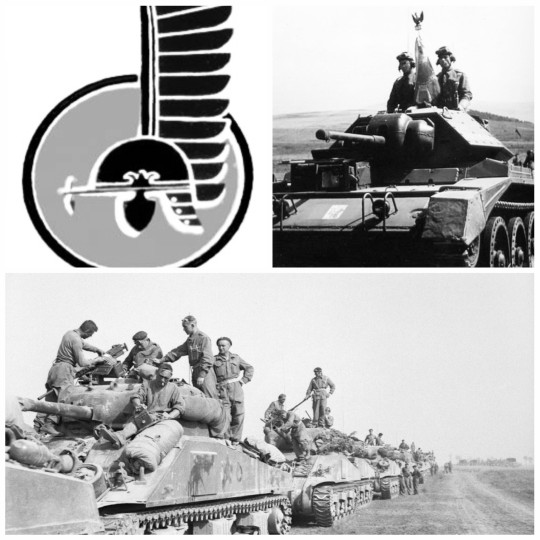
• Polish 1st Armoured Division
The Polish 1st Armoured Division was an armoured division formed as part of the Polish Armed Forces in the West during World War II.
After the fall of Poland and then France in 1940, the remaining Poles that had fought in both campaigns retreated with the British Army to the United Kingdom. Stationed in Scotland the Polish 1st Armoured Division was formed as part of the Polish I Corps under Wladyslaw Sikorski, which guarded approximately 200 kilometres of British coast in 1940-1941. The commander of the Division, General Stanislaw Maczek, was Poland’s premier mechanized commander, and many of his subordinate officers from the unit he commanded in 1939, the 10th Mechanized Brigade, had made their way to Britain with him. They were organized on the British Armoured Division model, equipped with British uniforms, weapons and tanks. They were initially equipped and trained on Crusader tanks but in late 1943 and early 1944 these were replaced with Sherman tanks and Cromwell tanks.
By the end of July 1944, the 1st Armoured had been transferred to Normandy, its final elements arriving on August 1st. The unit was attached to the First Canadian Army as part of the 21st Army Group. This may have been done to help in communication, as the vast majority of Poles did not speak English when they arrived in United Kingdom from 1940 onwards. The Division joined combat on August 8th, during Operation Totalize. It suffered serious casualties as a result of "friendly fire" from Allied aircraft, but achieved a victory against the Wehrmacht in the battles for Mont Ormel, and the town of Chambois. This series of offensive and defensive operations came to be known as the Battle of Falaise, in which a large number of German Army and SS divisions were trapped in the Falaise Pocket and subsequently destroyed. Maczek's division had the crucial role of closing the pocket at the escape route of the trapped German divisions, hence the fighting was desperate and the 2nd Polish Armoured Regiment, 24th Polish Lancers and 10th Dragoons, supported by the 8th and 9th Infantry Battalions, took the brunt of German attacks by units attempting to break free from the pocket. Surrounded and running out of ammunition, they withstood incessant attacks from multiple fleeing panzer divisions for 48 hours until they were relieved. The total losses of the division from August 7th when it entered combat until the end of the battle of Falaise on August 22nd were 446 killed, 1501 wounded, and 150 missing, or 2097 soldiers in total during about two weeks of fighting.
After the Allied armies broke out from Normandy, the Polish 1st Armoured Division pursued the Germans along the coast of the English Channel. It liberated, among others, the towns of Saint-Omer, Ypres, Oostnieuwkerke, Roeselare, Tielt, Ruislede, and Ghent. During Operation Pheasant a successful outflanking manoeuvre planned and performed by General Maczek allowed the liberation of the city of Breda without any civilian casualties. The Division spent the winter of 1944-1945 on the south bank of the river Rhine, guarding a sector around Moerdijk, Netherlands. In early 1945, it was transferred to the province of Overijssel and started to push with the Allies along the Dutch-German border, liberating the eastern parts of the provinces of Drenthe and Groningen including the towns of Emmen, Coevorden and Stadskanaal.
In April 1945, the 1st Armoured entered Germany in the area of Emsland. On May 6th, the Division seized the Kriegsmarine naval base in Wilhelmshaven, where General Maczek accepted the capitulation of the fortress, naval base, East Frisian Fleet and more than 10 infantry divisions. There the Division ended the war and, joined by the Polish 1st Independent Parachute Brigade, undertook occupation duties until it was disbanded in 1947; it, together with the many Polish displaced persons in the Western occupied territories, formed a Polish enclave at Haren in Germany, which was for a while known as "Maczków". The majority of its soldiers opted not to return to Poland, which fell under Soviet occupation, preferring instead to remain in exile. Many artefacts and memorabilia belonging to Maczek and the 1st Polish Armoured Division are on display in the Polish Institute and Sikorski Museum in London.
#second world war#world war 2#world war ii#military history#wwii#history#british history#polish history#tank history#tank warfare#tanks#battle of normandy
168 notes
·
View notes
Text
COMMEMORATIVE MESSAGE IN HONOR OF THE 189TH ANNIVERSARY OF THE END OF THE JUNE REBELLION AND THE 77TH ANNIVERSARY OF THE D-DAY SEABORNE LANDINGS
Ladies and gentlemen, to all the people of the United States of America and Canada, to all our remaining living veterans of the Second World War of 1939-1945 and of all conflicts past and present and their families, to our veterans, active servicemen and women, reservists and families of the entire United States Armed Forces and Canadian Armed Forces, and to all the uniformed military and civil security services of the Allied combatants of this conflict, to all the immediate families, relatives, children and grandchildren of the deceased veterans, fallen service personnel and wounded personnel of our military services and civil uniformed security and civil defense services, to all our workers, farmers and intellectuals, to our youth and personnel serving in youth uniformed and cadet organizations and all our athletes, coaches, judges, sports trainers and sports officials, and to all our sports fans, to all our workers of culture, music, traditional arts and the theatrical arts, radio, television, digital media and social media, cinema, heavy and light industry, agriculture, business, tourism and the press, and to all our people of the free world:
Today, in the midst of the global pandemic, and with the end now in sight with vaccinations being done in many countries, we once more honor two memorable events of our history.
189 years ago, in 1832 at a cost of hundreds of lives, the Paris Rebellion of July 1832 was ended when Frnech Army servicemen crushed the rebellion of students and workersof the capital demanding moral reforms and for France’s stronger foreign policies and stronger military so that it can help European independence movements.
77 years ago, under the overall leadership of the Supreme Allied Commander Europe General Dwight Eisenhower, with the paratroopers that had landed earlier having met their landing objectives and were now fighting behind enemy lines, a million-strong multinational landing force made up of personnel from many Allied national armed forces, mainly composed of personnel from the United Kingdom, Canada, United States and France, together with forces from many more countries, with naval and air support also from multinational forces, landed on 5 pre-designated beaches in Normandy in France, which had been under Axis occupation for over 4 years. This second front would finally begin as in each of these beaches, regardless of enemy resistance and full of determination and courage, these infantrymen, gunners, tankers and support personnel landed on the soils of occupied western Europe to begin the long awaited Allied military operations for the liberation of this part of the world, one that they have prepared for years, just as their fellow servicemen where fighting in Italy, Eastern Europe, and Yugoslavia. The D-Day seaborne landings were one of the first ever in modern times to be successfully conducted and thus proved to be a historic victory, the first of many that would finally bring an an end of the Nazi occupation of most of Europe and bring fascism to a smashing defeat. Working hand in hand, these men and women of the Allied Powers provided the manpower and equipment for the success of one of the greatest amphibious operations of modern history.
As the days and hours came and went, the victory of Normandy would be the first of many victories won in mainland Western Europe by the Allies, the first on the long road to the great victory in the spring of 1945 and the surrender of Germany to the triumphant Allied Powers. It was indeed thanks to these millions of men and women whose bravery and determination, at the cost of thousands of lives lost to the Axis, made the D-Day operation a success as they pushed opened the door towards the long road of victory against Nazi Germany.
Today, we honor and celebrate these two great events that will forever be a part of human history. Forever remembered in books, theater, visual arts, radio and television, these two great events are forever a part of our heritage and our common memory, as these have no dobut became a part of the long history of the human race. Spread on the same day years apart, they deserve to be remembered and commemorated today for generation after generation.
The heroes of 1832 fought for their country’s place in the world, the heroes of 1944 fought for global freedom and independence against Nazi Germany and international fascism. Then as in today, no matter what the situation in the world may be today, we will never let the memories of these events fade and promise once more to let the legacy live on for our future generations, for the sake of our dreams and goals for a better world!
Today, as we mark Canadian Armed Forces Day and Swedish National Day, we also thank the men and women of the Canadian Armed Forces and the Swedish Armed Forces for the service and determination for the defense of the freedom and sovereignty of their countries, as well as for the protection of their people and national interests.
LONG LIVE THE 189TH ANNIVERSARY OF THE 1832 JUNE REBELLION!
LONG LIVE THE 77TH YEAR ANNIVERSARY OF THE D-DAY OFFENSIVE OF 1944!
ETERNAL GLORY TO ALL THOSE WHO GAVE THEIR LIVES FOR THE FREEDOM AND INDEPENDENCE OF OUR WORLD!
ETERNAL GLORY TO ALL THOSE WHO FOUGHT AGAINST THE FORCES OF FASCISM AND LIBERATED THE WORLD FROM THE THREATS AND EVIL ACTIONS OF THE AXIS POWERS!
GLORY TO THE VICTORIOUS PEOPLE OF THE UNITED STATES OF AMERICA, CANADA, SWEDEN AND THEIR UNIFORMED SERVICES!
GLORY TO THE ARMED FORCES OF THE UNITED STATES OF AMERICA, CANADA AND SWEDEN, TOGETHER THE DEFENDERS OF OUR FREEDOM AND LIBERTY AND GUARANTEE OF A FUTURE WORTHY OF OUR GENERATIONS TO COME!
And in honor of the 77th year anniversary of the great baptism of fire of the 101st Airborne Division, and to the entire HBO War Fandom who for all time will always remember this very moment in history as depicted in the 2nd episode of the award winning 2001 HBO miniseries “Band of Brothers”:
LONG LIVE EASY COMPANY, 2ND BATTALION, 506TH PARACHUTE INFANTRY REGIMENT, 3RD BRIGADE COMBAT TEAM, 101ST AIRBORNE DIVISION (AIR ASSAULT), XVIII AIRBORNE CORPS, UNITED STATES ARMY!
CURRAHEE! AIR ASSAULT! ARMY STRONG! HOOOAH!!
1800h, June 6, 2021, the 245th year of the United States of America, the 246th year of the United States Army, Navy and Marine Corps, the 127th of the International Olympic Committee, the 125th of the Olympic Games, the 103rd since the conclusion of the First World War, the 82nd of the beginning of the Second World War in Europe, the 80th since the beginning of the Second World War in the Eastern Front and in the Pacific Theater, the 76th since the battles of Iwo Jima and Okinawa and the victories in Europe and the Pacific, the 74th of the United States Armed Forces and the 54th of the modern Canadian Armed Forces.
Semper Fortis A Mari Usque A Mare
John Ramos-Henderson
Makati City, Philippines
Grandson of Philippine Navy veteran PO2 Paterno Cueno, PN (Ret.)
(Requiem for a Soldier and The Mission Begins)
#hbo war#band of brothers#d-day#easy company#d-day 77#les miserables#barricade day#les mis#dday77#hbo war fandom
15 notes
·
View notes
Note
hello!! re: rossi, i've been meaning to ask you if there is any significance of the big blue & white patches on his jacket sleeves? i honestly just noticed he had them.
it’s so funny that you ask that because i have been agonising over this for months. and honestly? it is spectacularly difficult to find out what that fucking patch is. my first thought, when i saw 1917 for the first time and realised he was scottish, was that it was some sort of identifier of that fact - it’s the scottish colours, after all, and maybe it would make some sort of sense that a scotsman in an english regiment would be identified? but that idea is flimsy at best and isn’t backed up by any evidence whatsoever.
my next thought, through hours of attempts at research that are eternally thwarted by the fucking goddamn canadians and australians who seemingly have a much better record of that sort of thing than the british GOD BLESS, is that he may have been part of the signal corps, or the corps of royal engineers. as far as i can glean from this, it might make sense that a spattering of individual signallers would be attached to an infantry regiment, and that they then may have fought alongside the frontline troops, as they do now.
and, if he were a signaller, rossi would then have been trained in horse riding, would have been tasked with ensuring that “intelligence is passed to the decision makers and the mechanisms by which decisions and orders are communicated”, operating battlefield communication systems like telephones and radios, and possibly photography, both for military purposes and for propaganda and civilian news back home.
but that theory again falls short when you take into account the fact that the badge on rossi’s helmet is not the insignia of the signal corps - and i haven’t yet been able to identify which insignia it is.
and yet another thing has been bothering me: while scho and blake wear a red patch on their shoulders, which, as far as i’ve been able to gather, simply means infantry, the convoy boys wear either green patches (embroidered with a regiment name, or just blank) or red x’s. is it a battle patch, a way of distinguishing regiments at a glance? is it the patch of the 50th (northumbrian) division? does it mean HQ battalion, or division HQ? is the red x the patch of the 112th brigade? does it mean something other than infantry? machine gunners?
is could be the staffordshire regiment, which looks very similar to it, and which would make sense considering they were most likely part of one of these divisions that fought at arras in april, one of which encompassed two battalions of the north staffordshire regiment: the 31st division, my personal favourite possibility, because they fought in the battle of the scarpe at arras, because it’s mostly made up of northern regiments, and because it followed after the newfoundlands to the new hindenburg line in spring 1917, just like captain smith said; the 37th division, which contained both the 8th (service) battalion of the east lancashire regiment and the 10th (service) battalion of the loyal north lancashire regiment, which would align with the presence of liverpudlian soldiers, and, since it also contained yorkshire regiments, would also account of the fact that atkins wears the red x; the 19th (western) division; the 7th infantry division; and the 62nd (2nd west riding) division.
but again, the north staffordshire helmet badge is a very fucking distinctive pretzel knot, and rossi’s badge looks like this:
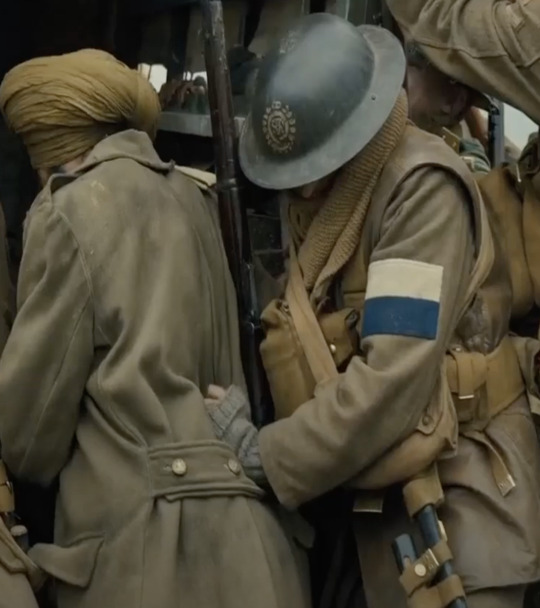
(and can we also just appreciate that rossi is doing the absolute bare minimum with pushing the truck and he’s mainly just pushing into jondalar’s back, we love to see him thriving and pretending to help) (and we also love that he wears mittens and that his scarf is so lovely and clean, kilgour is quaking)
and rossi doesn’t wear the green arm patch at all!!! which may legitimise the signaller theory?
so, to answer your question, my love: i don’t know. i honestly don’t know, and it absolutely kills me and my pride to say that. i’ll keep digging, but for now my best guess is that he was in the royal signal corps. and you know what? even if that’s wrong, it makes for a pretty cute headcanon. i always love characters who have something a little different and special about them, and being a signaller or royal engineer in the middle of an infantry battalion, being the one who has to report to the officers and communicate information and handle technical things like radios, that no one else would have any idea about and that would have been a thing of awe and mystery in the edwardian age, in the middle of a battle - having to be calm and shout down a phone line while shells are exploding all around him... i like that. and if he were indirectly in charge of propaganda footage and photography, and privy to the internal workings and politics of the army, that would have naturally led to the quiet, bitter cynicism of “look at it. fucking look at it. three years fighting over this.”
WAIT
NO
ANON
I’VE BEEN A FOOL:

THEY’RE FROM THE WORCESTERSHIRE REGIMENT!!!!!!!!!!! AND THE 10TH (SERVICE) BATTALION WAS ASSIGNED TO THE 19TH (WESTERN) DIVISION!!!! LIKE I SAID BEFORE!!! SO I WAS HALF RIGHT!!!
WE HAVE A NAME, LADS!!!! 10TH BATTALION OF THE WORCESTERSHIRE REGIMENT!!!! and man oh man, there are some stories about the insolence and rowdiness of the worcestershires!!! and that fits in so brilliantly with their personalities, I LOVE IT!!!!
still, though, rossi’s helmet badge really doesn’t seem to be the worcestershire lion and, as far as i can make out, has a crown atop the insignia, so who knows what tf that boy is wearing.
but that is completely off track, i’m so sorry my love LMAO. so yes: the arm patch you were actually asking about may mean that he was a signaller attached to the worcestershires ♡♡♡♡ we got there in the end!!! ilysm!! x
#i love you!!!! sorry this just became me overcompensating for the insecurity of NOT KNOWING ASDGIUAGDUAKS#asks#anon#1917#mine#<3333 thank you for the ask my sweet#this was one of the very first things i tried to find out back when 1917 was still in cinemas so it was a blast from the past to#get back into the research!!!! ilysm <333333#i feel like these kinds of asks really show my train of thought because they end up a total mess of oh and then i found THIS!!!!#like a chaotic show and tell#BLESS#also this is SUCH a funny coincidence because in the episode of endeavour i was watching today#one of the guys was in the worcestershire regiment so! the stars truly aligned this afternoon#we love to see it#MWAH
69 notes
·
View notes
Photo
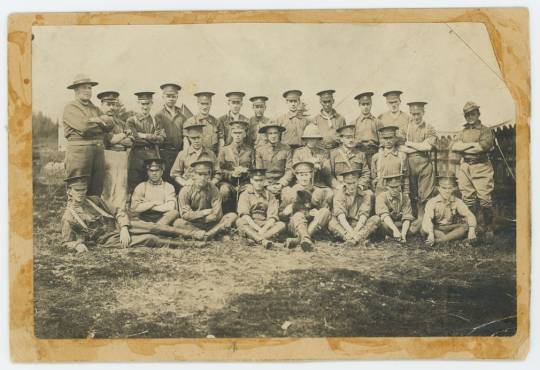
Winnie With the 2nd Canadian Infantry Brigade .. ‘Winnie sitting on a soldier's lap in Valcartier, Québec’ ..
10 notes
·
View notes
Photo

Lt. Harry Colebourn feeding Winnie in Salisbury Plain, England - 1914 The real story of Winnie the Pooh. In 1914 Lt. Colebourn purchased an orphaned bear from a White River Ontario hunter for $20. Weeks later he was shipped out to Europe in the early days of the First World War. Colebourn took the cub (named Winnie after his hometown of Winnipeg) with him to England where it became the unofficial mascot for Colebourn's unit, the 2nd Canadian Infantry Brigade. When it was time to fight in France, Colebourn loaned his beloved pet to the London Zoo where it caught the eye of A.A. Milne and his son, Christopher Robin. Winnie became the inspiration for the book Winnie the Pooh, which has since been published in more than 45 languages and has sold more than 20 million copies worldwide. - #winniethepooh #aamilne #christopherrobin #worldwar1 #bear #vintagephotograph #ww1 #wwi #1914to1918 #londonzoo #history #art #bookstagram https://www.instagram.com/p/B-meGXjj3Lq/?igshid=1l1nq6nv385pd
#winniethepooh#aamilne#christopherrobin#worldwar1#bear#vintagephotograph#ww1#wwi#1914to1918#londonzoo#history#art#bookstagram
15 notes
·
View notes
Photo

Soldiers of the Canadian Expeditionary Force, possibly 25th Battalion (Nova Scotia Rifles) of the 5th Infantry Brigade, 2nd Infantry Division eating rations whilst seated on muddy ground outside a shelter near Pozieres, October 1916, during the final stages of the Battle of the Somme, possibly during the Battle of Le Transloy.
#wwi#ww1#world war one artillery#world war one#The First World War#The Great War#1917#1918#British history#history#historical photos#world history#anzac#remembrance day#canada#canadian#canada remembers#military history#French History#british army
46 notes
·
View notes
Text
Korean War Tag List
Here is the tag list for the Korean War as it currently stands:
General Tags
Korean War
Cold War
Battles
Battle of Chosin Reservoir
Battle of the Imjin River
Battle Of Incheon
Battle of Old Baldy
Second Battle of Seoul
Second Battle of Naktong Bulge
Second Battle of the Hook
Fourth Battle of the Hook
Battle of Taejon
Battle of Miudong
Battle of Yultong
Locations
Chorwon
Daejeon
Hong Kong
Kimpo Air Base
Heartbreak Ridge
Hagaru-ri
Han River
Hyesan
Inje County
Iwakuni
Singapore
Seoul
Suncheon
Suwon
Miryang
Osan Air Base
Pyongyang
Waegwan
Yalu River
United States
Army
US Army
8th Army
1st Cavalry Division
2nd Infantry Division
2nd Engineer Battalion
7th Cavalry Regiment
7th Infantry Division
17th Infantry Regiment
24th Infantry Division
25th Infantry Division
27th Infantry Regiment
40th Infantry Division
45th Infantry Division
51st Signal Battalion
65th Infantry Regiment
77th Engineer Combat Company
89th Medium Tank Battalion
196th Field Artillery Battalion
388th Engineer Pipeline Company
398th Anti-Aircraft Artillery AW Battalion
937th Field Artillery Battalion
Marines
1st Marine Division
1st Provisional Marine Brigade
7th Marines
11th Marine Regiment
US Marines
Navy
US Navy
VMJ-1
VF-24
VF-51
VMF-212
USS Badoeng Strait
Air Force
US Air Force
3rd Bombardment Wing
17th Bombardment Group
51st Fighter Interceptor Wing
67th Tactical Reconnaissance Wing
452nd Bombardment Wing
731st Bombardment Squadron
Britain
Army
British Army
Royal Artillery
Royal Army Service Corps
royal engineers
5th Royal Inniskilling Dragoon Guards
7th Royal Tank Regiment
8th King’s Royal Irish Hussars
27th Infantry Brigade
29th Infantry Brigade
King's Own Scottish Borderers
King's Shropshire Light Infantry
The Gloucestershire Regiment
Essex Regiment
Middlesex Regiment
Royal Norfolk Regiment
Royal Leicestershire Regiment
Royal Ulster Rifles
Black Watch
Argyll and Sutherland Highlanders
Duke of Wellington's Regiment
Air Force
Royal Air Force
Navy
Royal Navy
800 Naval Air Squadron
802 Naval Air Squadron
Australia
Army
Australian Army
1RAR
2RAR
3RAR
Air Force
Royal Australian Air Force
No.77 Squadron
No.491 Squadron
United Nations
United Nations
Philippines
PEFTOK
2nd Battalion Combat Team
10th Battalion Combat Team
14th Battalion Combat Team
19th Battalion Combat Team
20th Battalion Combat Team
Commonwealth
1st Commonwealth Division
Colombia
Colombian Army
Colombian Navy
Canada
Canadian Army
Princess Patricia's Canadian Light Infantry
Lord Strathcona's Horse (Royal Canadians)
The Royal Canadian Regiment
Royal 22nd Regiment
25th Canadian Infantry Brigade
Ethiopia
Ethiopian Army
Turkey
turkish army
Greece
greek army
South Korea
1st Infantry Division
8th Infantry Division
South Korean Army
South Korean Marines
Korean Service Corps
North Korea
North Korean Army
China
People's Liberation Army
14 notes
·
View notes
Text
Events 8.19
295 BC – The first temple to Venus, the Roman goddess of love, beauty and fertility, is dedicated by Quintus Fabius Maximus Gurges during the Third Samnite War.
43 BC – Gaius Julius Caesar Octavianus, later known as Augustus, compels the Roman Senate to elect him Consul.
947 – Abu Yazid, a Kharijite rebel leader, is defeated and killed in the Hodna Mountains in modern-day Algeria by Fatimid forces.
1153 – Baldwin III of Jerusalem takes control of the Kingdom of Jerusalem from his mother Melisende, and also captures Ascalon.
1458 – Pope Pius II becomes the 211th Pope.
1504 – In Ireland, the Hiberno-Norman de Burghs (Burkes) and Anglo-Norman Fitzgeralds fight in the Battle of Knockdoe.
1561 – Mary, Queen of Scots, who was 18 years old, returns to Scotland after spending 13 years in France.
1612 – The "Samlesbury witches", three women from the Lancashire village of Samlesbury, England, are put on trial, accused of practicing witchcraft, one of the most famous witch trials in British history.
1666 – Second Anglo-Dutch War: Rear Admiral Robert Holmes leads a raid on the Dutch island of Terschelling, destroying 150 merchant ships, an act later known as "Holmes's Bonfire".
1692 – Salem witch trials: In Salem, Province of Massachusetts Bay, five people, one woman and four men, including a clergyman, are executed after being convicted of witchcraft.
1745 – Prince Charles Edward Stuart raises his standard in Glenfinnan: The start of the Second Jacobite Rebellion, known as "the 45".
1745 – Ottoman–Persian War: In the Battle of Kars, the Ottoman army is routed by Persian forces led by Nader Shah.
1759 – Battle of Lagos Naval battle during the Seven Years' War between Great Britain and France.
1772 – Gustav III of Sweden stages a coup d'état, in which he assumes power and enacts a new constitution that divides power between the Riksdag and the King.
1782 – American Revolutionary War: Battle of Blue Licks: The last major engagement of the war, almost ten months after the surrender of the British commander Charles Cornwallis following the Siege of Yorktown.
1812 – War of 1812: American frigate USS Constitution defeats the British frigate HMS Guerriere off the coast of Nova Scotia, Canada earning the nickname "Old Ironsides".
1813 – Gervasio Antonio de Posadas joins Argentina's Second Triumvirate.
1839 – The French government announces that Louis Daguerre's photographic process is a gift "free to the world".
1848 – California Gold Rush: The New York Herald breaks the news to the East Coast of the United States of the gold rush in California (although the rush started in January).
1854 – The First Sioux War begins when United States Army soldiers kill Lakota chief Conquering Bear and in return are massacred.
1861 – First ascent of Weisshorn, fifth highest summit in the Alps.
1862 – American Indian Wars: During an uprising in Minnesota, Lakota warriors decide not to attack heavily defended Fort Ridgely and instead turn to the settlement of New Ulm, killing white settlers along the way.
1909 – The Indianapolis Motor Speedway opens for automobile racing. Wilfred Bourque and his mechanic are killed during the first day's events.
1920 – The Tambov Rebellion breaks out, in response to the Bolshevik policy of Prodrazvyorstka.
1927 – Patriarch Sergius of Moscow proclaims the declaration of loyalty of the Russian Orthodox Church to the Soviet Union.
1934 – The first All-American Soap Box Derby is held in Dayton, Ohio.
1934 – The German referendum of 1934 approves Hitler's appointment as head of state with the title of Führer.
1936 – The Great Purge of the Soviet Union begins when the first of the Moscow Trials is convened.
1940 – First flight of the B-25 Mitchell medium bomber.
1941 – Germany and Romania sign the Tiraspol Agreement, rendering the region of Transnistria under control of the latter.
1942 – World War II: Operation Jubilee: The 2nd Canadian Infantry Division leads an amphibious assault by allied forces on Dieppe, France and fails, many Canadians are killed or captured. The operation was intended to develop and try new amphibious landing tactics for the coming full invasion in Normandy.
1944 – World War II: Liberation of Paris: Paris, France rises against German occupation with the help of Allied troops.
1945 – August Revolution: Viet Minh led by Ho Chi Minh take power in Hanoi, Vietnam.
1953 – Cold War: The CIA and MI6 help to overthrow the government of Mohammad Mosaddegh in Iran and reinstate the Shah Mohammad Reza Pahlavi.
1955 – In the Northeast United States, severe flooding caused by Hurricane Diane, claims 200 lives.
1960 – Cold War: In Moscow, Russia, Soviet Union, downed American U-2 pilot Francis Gary Powers is sentenced to ten years imprisonment by the Soviet Union for espionage.
1960 – Sputnik program: Korabl-Sputnik 2: The Soviet Union launches the satellite with the dogs Belka and Strelka, 40 mice, two rats and a variety of plants.
1964 – Syncom 3, the first geostationary communication satellite, is launched. Two months later, it would enable live coverage of the 1964 Summer Olympics.
1965 – Japanese prime minister Eisaku Satō becomes the first post-World War II sitting prime minister to visit Okinawa Prefecture.
1978 – In Iran, Cinema Rex fire caused more than 400 deaths.
1980 – Saudia Flight 163, a Lockheed L-1011 TriStar burns after making an emergency landing at King Khalid International Airport in Riyadh, Saudi Arabia, killing 301 people.
1981 – Gulf of Sidra Incident: United States fighters intercept and shoot down two Libyan Sukhoi Su-22 fighter jets over the Gulf of Sidra.
1987 – Hungerford massacre: In the United Kingdom, Michael Ryan kills sixteen people with a semi-automatic rifle and then commits suicide.
1989 – Polish president Wojciech Jaruzelski nominates Solidarity activist Tadeusz Mazowiecki to be the first non-communist prime minister in 42 years.
1989 – Several hundred East Germans cross the frontier between Hungary and Austria during the Pan-European Picnic, part of the events that began the process of the Fall of the Berlin Wall.
1991 – Dissolution of the Soviet Union, August Coup: Soviet President Mikhail Gorbachev is placed under house arrest while on holiday in the town of Foros, Ukraine.
1991 – Crown Heights riot begins.
1999 – In Belgrade, Yugoslavia, tens of thousands of Serbians rally to demand the resignation of Federal Republic of Yugoslavia President Slobodan Milošević.
2002 – Khankala Mi-26 crash: A Russian Mil Mi-26 helicopter carrying troops is hit by a Chechen missile outside Grozny, killing 118 soldiers.
2003 – A car-bomb attack on United Nations headquarters in Iraq kills the agency's top envoy Sérgio Vieira de Mello and 21 other employees.
2003 – A suicide attack on a bus in Jerusalem, Israel, planned by Hamas, kills 23 Israelis, seven of them children, in the Shmuel HaNavi bus bombing.
2005 – The first-ever joint military exercise between Russia and China, called Peace Mission 2005 begins.
2009 – A series of bombings in Baghdad, Iraq, kills 101 and injures 565 others.
2010 – Operation Iraqi Freedom ends, with the last of the United States brigade combat teams crossing the border to Kuwait.
2013 – The Dhamara Ghat train accident kills at least 37 people in the Indian state of Bihar.
2017 – Tens of thousands of farmed non-native Atlantic salmon are accidentally released into the wild in Washington waters in the 2017 Cypress Island Atlantic salmon pen break.
5 notes
·
View notes
Text
Day Sixteen: Journey’s End
[Illustrated Version: https://aroundtheworldinsearchofcokev.blogspot.com/2019/07/day-sixteen-journeys-end.html]
Today we went to the bridge at Arnhem, to the Airborne Museum at Oosterbeek at to the cemetary at Oosterbeek. We then spent the afternoon in Arnhem. I’ve decided to focus on the history today, as it explains much of what I want to say better than a blow-by-blow account.
---
The British 1st Airborne Division dropped on Oosterbeek on the morning of 17 September 1944 - about five miles from their objective of Arnhem. The RAF had feared possible anti-aircraft guns around the Rhine Bridge, and refused to drop any closer.
Shortly after landing, General Roy Urquhart, having made his headquarters in a hotel recently evacuated by Generalfeldmarschall Walter Model, left to reconnoiter the area. By evening, he had not returned, and a dispute had broken out over who was to be in command while he was gone. He'd designated Brigadier Lathbury, but he was not the ranking officer. 1st Airborne command fell into paralysis.
In the mean time, a hodge-podge of the 2nd and 3rd Battalions of the Parachute Regiment had reached the bridge and dug in. They were under the command of Lieutenant-Colonel John Frost, who expected to have to hold the bridge for three days until XXX Corps arrived.
By the next day, he'd recieved no reinforcements from either Oosterbeek or the south. A reconnaissance column of the 9th SS Panzer, commanded by Victor Graebner, charged the bridge that morning but was without support and destroyed - Graebner was killed. But more and more of the SS were mobilising and moving in. The sitaithon became worse and worse.
Eventually, Urquhart returned to Oosterbeek - he had had to hide to evade German patrols. An attempt was made to relieve Frost, but by now the Germans had reached Arnhem in force. It was repulsed. The paratroopers on the bridge were doomed.
The Paras fought on until the end, and Arnhem was heavily damaged. At last, on the early morning of the 21st, Frost surrendered. At about five in the morning, a final radio transmission reported ‘out of ammunition; god save the King.’ The last hope of ending the war in 1944 died with them.
With Arnhem retaken, the SS scented blood. They began to push on the Oosterbeek pocket. John Barskeyfield, now a sergeant, manned an anti-tank gun and knocked out several tanks - it was enough to win the Victoria Cross. It was not enough to save his life. He died on the 20th of September, aged 21.
By now, XXX Corps had finally reached the southern bank of the Rhine, and the Polish had secured Driel. Horrocks advised an attempt to relieve the 1st Airborne to be performed by the Poles - Sosabowski, now commanding them, refused. He had never believed in Market Garden, and now perceived an attempt to sacrifice them in a doomed charge in boats in darkness over the Rhine. Correspondingly, XXX Corps sent some of its infantry - all it achieved was to trap even more men on the wrong side of the river - but Sosabowski’s refusal to send his brigade in made him an easy scapegoat for the ultimate failure of Market Garden, and he lost his command.
At last, the Allies bowed to the inevitable. Operation Berlin saw infantry of XXX Corps rowing over the Rhine to relieve their comrades in the 1st Airborne - or what remained of them. Of a division of around ten thousand men, only two thousand made it back over the river - another two thousand were killed, and the rest taken prisoner. Urquhart’s division had been effectively destroyed for no material gain.
For his part, Montgomery was content to claim that the operation was ninety percent successful. Nobody else saw it in such optimistic terms. Sosabowksi and Ramsey’s concerns were vindicated, and the Canadians began the bitter task of clearing the Scheldt Estuary. Monty’s reputation among the Americans, never great to begin with, never really recovered. American historians have savaged him (and often by extension, the British Army) ever since.
Market Garden was perhaps the nadir of Anglo-American cooperation. To the Americans, the British soldier was slow, unintelligent and at worst, dishonest, relying on Americans to do the bleeding for him. To the British, the American GI was unprofessional, impetuous, overly gung-ho and more than a little pompous. These stereotypes have persisted in the works of many historians to this day.
Yet the fact remains that all of the troops deployed in the battle performed to the best standard they could. Time and time again, they were let down by high command - particularly Browning and Gavin. They had been given a plan that was optimistic, rushed and made no account for the existence of opposition. Given what was asked, that they managed to be ‘ninety percent successful’ is itself astounding.
The Germans enacted a terrible revenge on the Dutch, who had supported the Allies every step of the way. The civilian population of Arnhem was forcibly removed, and nearly all food production, already meagre, was directed away from the Netherlands. Let this be clear; this was not wartime shortage, but a deliberate policy of punishment by Adolf Hitler, who had given up the last of his pretence of civility in an insane attempt to bring Europe down in flames with him. The Hunger Winter killed twenty thousand. This was not famine. It was murder.
Today the Netherlands are rebuilt. The road from Neerpelt to Arnhem can be driven in about two hours, three at most. The area has never forgotten Market Garden, and the road is pockmarked with memorials and museums to those September days. None of these are more stark then the rows of white headstones in graveyards along the way.
Over a thousand men still lie in Oosterbeek. Each grave is the same at a glance, with only the names and inscriptions distinguishing them in death. Many have epitaphs from family - wives, brothers, sisters and parents. Most are in their twenties. Many are eighteen or nineteen. Lieutenants barely out of college commanded men at thirty or even older.
Historians, particularly military historians, like the word ‘only.’ When compared to the titanic battles on the Eastern Front, onlythirty thousand were killed, wounded or captured. Yet every single person who died meant something to somebody. They were somebody’s son, somebody’s daughter, somebody’s girlfriend, boyfriend, wife, husband, father or mother. They worked for somebody. They had friends and enemies. They lived and breathed and loved and lost. For some the end came instantly, for others only days.
Perhaps the most famous of the war poets was Wilfred Owen, who died on the 4th of November 1918, just a week before the war ended. One of his most famous works was Anthem for Doomed Youth- written for the men in the trenches of the First World War, but I feel is still fitting for the men dropped into Arnhem in 1944;
What passing-bells for these who die as cattle?
Only the monstrous anger of the guns.
Only the stuttering rifles' rapid rattle
Can patter out their hasty orisons.
No mockeries now for them; no prayers nor bells;
Nor any voice of mourning save the choirs,—
The shrill, demented choirs of wailing shells;
And bugles calling for them from sad shires.
What candles may be held to speed them all?
Not in the hands of boys, but in their eyes
Shall shine the holy glimmers of goodbyes.
The pallor of girls' brows shall be their pall;
Their flowers the tenderness of patient minds,
And each slow dusk a drawing-down of blinds.
1 note
·
View note
Text
The 4th Canadian Infantry Brigade (4th C.I.B.) was engaged at Passchendaele in November 1917. Compared with some other Canadian Brigades and Battalions it was not as heavily engaged but the costs to the Brigade was high. The 2nd Canadian Infantry Brigade suffered a total of 1,268 casualties (killed in action and wounded) with 73 men taken prisoner over a four-day period spanning November 8 to 11, 1917. In contrast, the 4th C.I.B. was subject to a loss of personnel by all causes of 695 soldiers of all ranks between November 1 to 12, 1917, a span of thirteen days.
2nd Canadian Infantry Brigade Casualty Report
4th Canadian Infantry Brigade Casualty Report

Wounded Canadians on way to aid-post. Battle of Passchendaele. November, 1917. Source: LAC. Online MIKAN no. 3194341 (1 item).
The 18th Battalion War Diary combines its entries for November 9 through 12, 1917 in one large entry spanning two pages and starts its description of these days thusly: “During the whole of this Tour, the Offices and men held this part of the line under the most severe conditions possible.”
The 4th C.I.B. enumerated is casualties for the period in its War Diary and the results are replicated below:

Data replication by author of Appendix 5A. 4th C.I.B. War Diary. November 1917.
Below is a matrix summarizing the total casualties by category data:

Summary. Data replication by author of Appendix 5A. 4th C.I.B. War Diary. November 1917.
The comparative differences in the numbers of soldiers of the 4th C.I.B. shows the numbers killed, wounded, missing (mostly missing, presumed dead and not prisoners), and gassed are apparent and the totals reflect the outcomes of the battalions most heavily engaged in the actions over those dates, the 19th and 21st Battalions. The 19th and the 21st Battalions was involved in repulsing a German attack on November 3, 1917 at 5:00 A.M. with the German attackers able to gain a foothold in the trenches of the 21st Battalion. The Battalion, with supporting units, counter-attacked and repulsed the attack with the German troops retiring. Later that morning, at 7:30 A.M., the 19th Battalion was again engaged in covering the left flank of an Australian Battalion.
On November 10, 1917, the 4th C.I.B. was involved in its own attack starting at Zero Hour at 6:05 A.M. and this engagement was successful and from the Brigade’s report on operations the engagement did not note any unusual casualty rates. It did note in its War Diary that this “Attack very successful.”
Yet, the two reports of the actions of the battalions of the 4th C.I.B. and the 18th Battalion war diary entries do no fully reflect the tempo of the action at Passchendaele. Fifty, or 86%, of the fifty-eight men of the 18th Battalion that died that month perished between November 9 and 12, 1917. The data above only shows that twenty-eight men were killed in action, with a balance of seventy-five being wounded. Clearly the “Corrected List of Casualties” is not correct and does not reflect the terrible cost of the Brigades involvement at Passchendaele.
The data is illustrative of the ratios of killed, wounded, gassed, and missing and help to give context and meaning to the events that the battalions of the 4th C.I.B. But the report on operations for the Brigade for November 12 and 13 expresses the outcome of the Brigade’s experiences at Passchendaele:
The behavior of the officers and men during the whole of these operations was of the highest standard. The conditions of the ground and the intensity of the enemy’s shelling created difficulties of [a] most severe character. The evacuation of the wounded was one of the hardest problems of the whole tour and only be the greatest devotion to duty by the stretcher bearer parties was the whole area cleared before being turned over to the relieving Brigade.
Source: 4th Canadian Infantry Brigade War Diary. November 1917. Appendix 6. Page 5.

Wounded Canadians on way to aid-post during the Battle of Passchendaele. Source: LAC. Online MIKAN no. 3397044 (1 item).
The Greatest Devotion to Duty: Casualties at Passchendaele The 4th Canadian Infantry Brigade (4th C.I.B.) was engaged at Passchendaele in November 1917. Compared with some other Canadian Brigades and Battalions it was not as heavily engaged but the costs to the Brigade was high.
#18th Battalion C.E.F.#19th Battalion C.E.F.#20th Battalion C.E.F.#21st Battalion C.E.F.#2nd Canadian Infantry Brigade#4th Canadian Infantry Brigade#4th Trench Mortar Battery#gassed in action#Killed in Action#Missing in Action#Passchendaele#stretcher bearers#Wounded in Action
0 notes
Text
One of the best spam emails I’ve ever received
Hello, Good day and compliments, I know this letter will definitely come to you as a surprise, but I implore you to take the time to go through it carefully as the decision you make will go off a long way to determine my future and continued existence. Please allow me to introduce myself. I am Sgt Marcus Graves, in 2nd Infantry Brigade Combat Team, 4th Infantry Division here that Patrols the Helmand Province, Afghanistan. I am desperately in need of assistance and I have summoned up courage to contact you.
I am presently in Afghanistan and I found your contact particulars in an address journal. I am seeking your assistance to evacuate the sum of $26m (Twenty Six Million United States Dollars) to you, as far as I can be assured that it will be safe in your care until I complete my service here. This is no stolen money and there are no dangers involved.
SOURCE OF MONEY:
Some money in US DOLLARS was discovered and concealed in barrels at a location in Helman Province when we conducted a foot patrol and it was agreed by all party present that the money be shared amongs us.This might appear as an illegal thing to do but I tell you what? No compensation can make up for the risks we have taken with our lives in this hellhole. The above figure was given to me as my share and to conceal this kind of money became a problem for me, so with the help of a Canadian contact working with the UN here (his office enjoys some immunity) I was able to get the package out to a safe location entirely out of trouble spot. He does not know the real contents of the package as he believes that it belongs to an American who died in an air raid, who before giving up trusted me to hand over the package to his close relative.
I have now found a secured way of getting the package out of Afghanistan for you to pick up. I do not know how long I will remain here, as I have been lucky to survive 2 suicide bomb attacks by Pure Divine intervention. This and other reasons put into consideration have prompted me to reach out for help. If it might be of interest to you then Endeavor to contact me immediately and we would work out the necessary formalities but I pray that you are discreet about this mutually benefiting relationship.
I promise to give you 40% of the total sum as your own share and 60% for me. I hope I am been fair on this deal,
The only telephone access we have here is radio message which is for our general use and is being monitored; therefore all communication will be via email till we finish our assignment.
Please keep it to yourself even if you are not interested.
Respectfully,
Sgt Marcus Graves,United States
Soldier:Afghanistan
I like this one because it really paints a picture, doesn’t it? “I can’t be scamming you because we’re scamming someone TOGETHER.”
24 notes
·
View notes